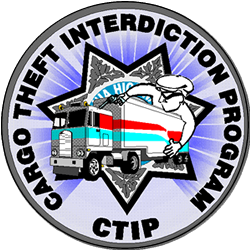Background
 In January of 1994, Assembly Bill 813 was passed which provided funding to implement and maintain ongoing statewide cargo theft suppression efforts. The Cargo Theft Interdiction Program (CTIP) was created to combat the ever increasing cargo theft problem. Over the past decade the cost of cargo theft related crimes has risen dramatically. It is estimated that combined losses suffered by the trucking industry, insurance companies, and the railroads, surpasses $10 BILLION in the United States annually. However, no financial total can adequately quantify the actual costs of cargo theft related losses which includes jobsite downtime, replacement of stolen commercial vehicles, time spent on additional paperwork, and increased insurance costs.
In January of 1994, Assembly Bill 813 was passed which provided funding to implement and maintain ongoing statewide cargo theft suppression efforts. The Cargo Theft Interdiction Program (CTIP) was created to combat the ever increasing cargo theft problem. Over the past decade the cost of cargo theft related crimes has risen dramatically. It is estimated that combined losses suffered by the trucking industry, insurance companies, and the railroads, surpasses $10 BILLION in the United States annually. However, no financial total can adequately quantify the actual costs of cargo theft related losses which includes jobsite downtime, replacement of stolen commercial vehicles, time spent on additional paperwork, and increased insurance costs.
Prior to 1994, in the State of California, no proactive enforcement specifically directed at cargo theft related crimes existed. Consequently, the criminal element determined that the level of profit derived from the theft of cargo loads far surpassed the risk of apprehension. What quickly became apparent to several unethical entrepreneurs was that profits derived from the theft and sale of cargoes were substantial and tax free. Thefts of sought after commodities such as televisions, camcorders, and computers, could reach a profit margin as high as 80 cents on the dollar. For example, an organized theft group with several reliable buyers, which stole a load of computers valued at $1 million, conceivably could earn as much as $800,000 from the sale of the stolen commodity.
In response to concerns from the California Trucking Association (CTA) over this rising problem, Assembly Bill 1683 was enacted. This legislation created funding for the enhancement of cargo theft enforcement statewide, and designated the California Highway Patrol (CHP) to coordinate and implement the program.
